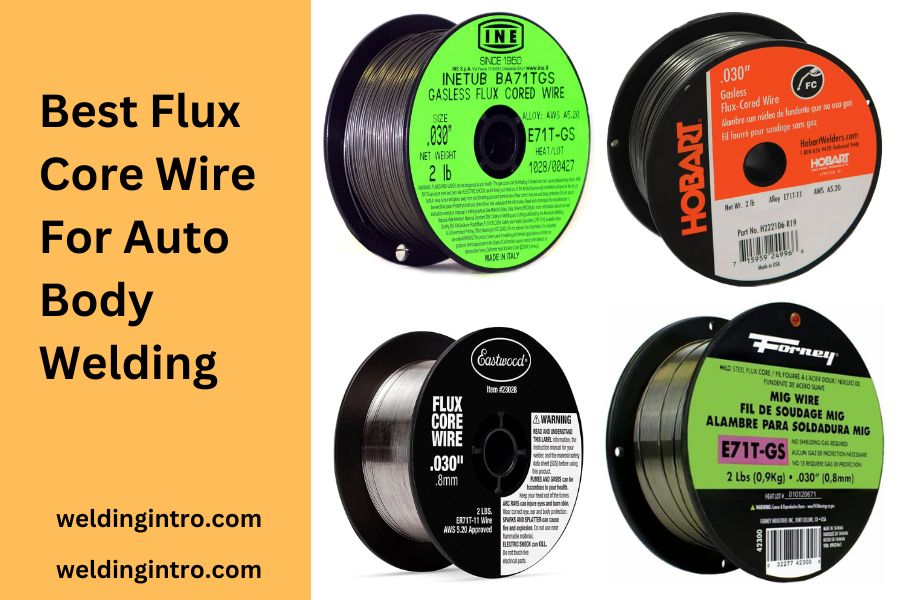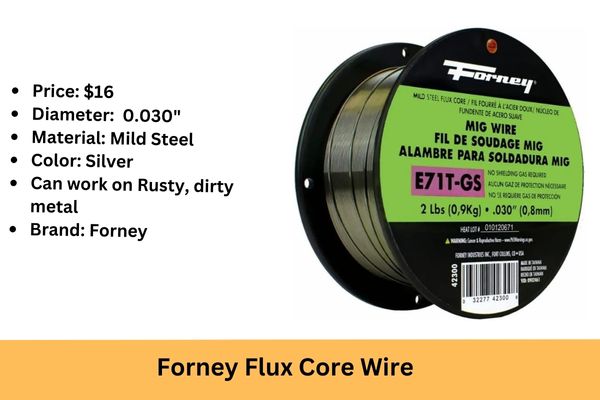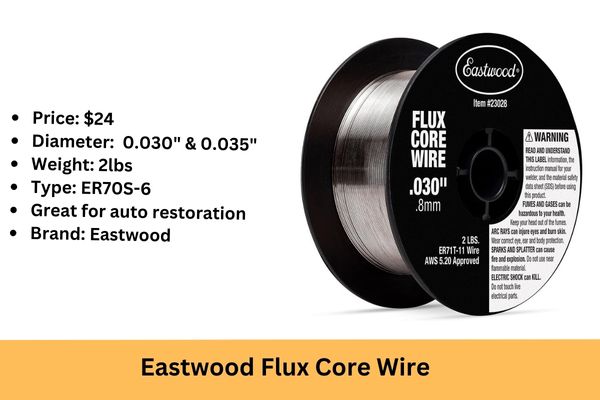Flux core wire, mostly referred to as FCW, is commonly used for repairing auto body projects, but why not use the stick welding when you don’t want to use any gas and wire feeders? The only but most important demerit of a stick electrode is you have to change the electrode frequently. That’s a big loss of time.
So, is the flux core presenting a versatile and indispensable tool in the realm of repairing the auto body? Big yes. It specializes in deep penetration capabilities, adaptability from different angles and different materials. Also, flux core wire allows the welders to work without any interruption.
There are many FCW available in the market, but if you want to find the best flux core wires for auto body welding, keep a few things in mind, such as material, puddle size, etc.
Let’s find out the best ones.
Best Flux Core Wires for Auto Body Welding
Here is the list of best auto body flux core wire
- Forney Flux Core Mig Wire (Best Overall )
- INETUB Flux Cored Welding Wire (Editors Choice)
- ARCCAPTAIN Flux Core Welding Wire (Best For Price)
- Hobart Flux-Cored Welding Wire (Best For Galvanized And Mild Steel)
- Eastwood Flux Core Welding Wire
Lets review the products in detail.

1. Forney 42300 Flux Core Mig Wire (Best Automotive Flux Core Wire)
The product is suitable for mild steel, and it is a self-shielded flux core wire, which means it is pretty good for outdoor activities. This wire suits with high travel speed on single pass application.
The diameter of the Forney 42300 flux core wire is 0.30 inches and, weighs 2 lbs, and has a tensile strength of 79.000 psi. This makes it ideal for rusty, dirty, and painted material.
The E71T wire runs hotter than other wires; it is very good on gauge mild steel. The classification of this wire means E stands for electrode, & indicates 70.000 psi tensile strength, one stands for all position wire, and finally, T stands for tubular wire. The remaining two letters, G, stands for
general, no other specifications, and S means single pass only.
This welding wire is intended to be used on rust spots, repairing structural auto body work, and fabricating custom panels. The formulation is tailored for flux core arc welding and is excellent for achieving strong, clean, and reliable welding.
Benefits
- Though a self-shielded flux core wire, it still doesn’t spread many splatters.
- Smooth, great burn, and easy to manipulate.
- The products come with a wire brush to clean the splatters.
- It is cheaper than HF Vulcan, OI Lincoln, etc.
Limitations
- You must take the wire very close to steel, like ¼ inches. Otherwise, a lot of tips will be created.
- The wires finish up quicker than other 0.030 flux core wires.
2. INETUB BA71TGS .030-Inch Carbon Steel Gasless Flux Cored Welding Wire
It is a self-shielded wire, ideal for welding outside and in rough conditions. The tensile strength is nearly 82.8ksi. The applications of Inetub carbon steel gasless flux core wire are repairing auto bodies, tanks, boilers, earthworks, steel buildings, etc.
As shielding is not required, both single and multipass welding is allowed. Moreover, it produces low splatter, removes easy slag, gives full slag coverage, and ensures excellent bead appearance.
The diameter of the wire is 0.030 inches, and the wires are made of combining 0.18 wt % C, 1.10 et % Mn, and 0.42 wt % SI.
Benefits
- Excellent welding wire for field repairing auto body.
- Deposition rate is higher than other flux core welding wires.
- The puddles look good and freezes faster.
- Excellent for MIG welding.
Limitations
- If you use a bigger spool the wire can cause handing and sticking again and again.
3. Hobart H222106-R19 Flux-Cored Welding Wire
The Hobart welding products have been ruling since 1917. All of their welding products are industry quality. The H222106-R19 carbon steel flux core wire has a diameter of 0.030 inches. This flux core wire is suitable for thin gauge galvanized and mild steel. It is also very popular for multi-pass welding.
Typically, this carbon steel-made flux core wire works great on a truck body. As it is a gas shielding flux core wire, it produces minimum splatter.
The Hobart flux-cored wire E71T-11 is great for light structure, machinery part fabrication, prefab construction, railroad car repair, and other auto body repairs.
Benefits
- Works smooth on a steel surface and holds up strong.
- Running at 110VAC, this flux core wire does the best job.
- Less splatter makes your after-welding work pretty simple.
Limitations
- Does not do well on the material thinner than 18ga.
4. ARCCAPTAIN E71T-GS Flux Core Welding Wire
Another flux core welding wire with no shielding gas and the total weight of the flux core is around 2 lbs. It provides smooth arc action, excellent performance, and high feed ability. You can use it on welding all the positions, multi and single-pass welding. Also very good at T joints, lap weld, and butt weld.
Now, talk a little about the material; it works great; anything steel, allow, would be good but also suitable for rusty, dirty, and painted materials. Suitable for both indoor and outdoor welding. To be more trustworthy, the Arc-captain passed the TUV test, which made the top-notch quality materials.
The diameter of this flux core wire is 0.030 inches and is totally self-shielded. The tensile strength is almost 81000 psi.
Benefits
- It doesn’t even backlash the whole spool.
- Less splatter and weld better than other expensive wires.
- Supports all position welding angles.
- Works on various ranges of metals, like tanks, ornament iron, auto body, etc.
Limitations
- Much expensive in price.
5. Eastwood .030 Flux Core Welding Wire
It is a consistent performer that meets all the AWS standards. Though Eastwood is a renowned brand, it works well on other manufactured machines, too. The 4-inch 2lbs spool ensures a smooth feeling along with a consistent wire speed.
The wire diameter is 0.030 inches, and the wire type is ER70S-6. The bead profile is surprisingly good, also it ensures excellent splatter control. As it is certified by AWS, it works unbelievably well on dirt, rust, and mill-scale surfaces.
The single pass welding is suitable for sheet metal applications, and multiple-pass weld works great on thick metal.
Benefits
- Suitable for all position welding.
- Metals medium to high are good for this flux core wire.
- Excellent bead profile
- Certified flux core wire, so there is no risk of compromising about the quality.
Limitations
- The item weighs a bit heavy and is also expensive in price.
Importance of Choosing the Right Flux Core Wire
The right flux core wire for auto body welding is paramount for achieving a visually appealing, clean, and strong weld. The flux core wire is directly related with weld penetration, weld quality, and bead appearance. Let’s know a bit about them.
1. Durable and Strong Weld
We select appropriate flux core wire because autobody welding material has requirements for being welded. So, the right FCW ensures a secured welding bond with the base material, enhancing structural integrity and durability. In contrast, an incompatible wire can result in weak welding and compromise the safety.
2. Clean Welds
Different flux core wires have different levels of impurity-removing agents in their flux composition. So, to minimize the contamination of the weld, you need the right flux wire. Clean weld looks good and is less prone to defects like porosity that allows air to enter, and thus the weld loses its strength.
3. Visual Appeal
As it is, the auto body demands to look aesthetically beautiful, so the selection of flux core wire massively impacts the appearance of the weld bead. The right wire produces a visually appealing, smooth, and consistent weld that seamlessly blends with auto body material.
In contrast, compatible flux wire produces a rough and inconsistent bead appearance.
4. Weld Penetration
For strong and reliable bonds, the right weld penetration is what you need. The choice of
flux core diameter and composition material have an effect on deep penetration. Inadequate penetration will happen for incorrect flux wire.
Key Factors to Consider
When choosing a flux core auto body welding, you must look at several factors and take them into account to ensure the best result. The factors include:
1. Wire Diameter and Spool size
It has significant effects on weld penetration and the amount of heat delivered to the workpiece. Thicker wires like (0.0030 inches) flux core wire are suitable for thicker auto body panels, and thinner wires (0.0030 inches) work well on thinner materials.
Spool size is what we really keep in mind for flux core because flux core is popular for its large spool size, and that suits the more extensive projects and reduces downtime.
2. Material Compatibility
The selected flux core must be compatible with the specific materials you will be welding on the auto body panels. Different thickness of steel like mild and, stainless requires different wires. Using the right metal is crucial.
3. Wire Classification
Flux core wire has a category as they have different applications. So, pay your attention to the wire classifications, such as E&1T-GS or E71T-11. That has the information on the wire’s suitability for certain welding positions and surrounding conditions. So, select the classification that aligns with the auto body you are going to work on.
4. Gas vs Glasses
Two types of flux-cored wires are available: gas-shielded and gasless or self-shielding. A gas shielded requires an external shielding gas. Typically, the gas is a combination of CO2 and argon. Gas-shielded flux core wires often provide less splatter and cleaner welds. Also suitable for indoor welding.
The self-shielding flux cored wires are more portable and very much suitable for windy outdoor welding. But it produces more splatter. And the resulting weld doesn’t look fresh.
Tips For Successful Auto Body Welding
Here, we’ll give you some practical tips about successful auto welds using flux core; let’s dive in.
1. Surface Preparation
- Cleanness: you must ensure the surfaces to be joined are clean and free from rust, paint dirt, and liquid contaminants. Use a wire brush, grinder, and sandpaper to clean the surface as much as possible.
- Fit and Alignment: now ensure the pieces you are going to weld they are aligned perfectly. Misalignment leads to weak, weak, and uneven welds.
2. Joint Design
- Right Joint Selection: It’s a must to choose the appropriate design for the auto body projects. There are some common joints like butt joints, lap joints, and T-joints; you must choose them according to the thickness of the material, now my randomly.
- Bevel for Thickness: thicker materials are not easy to join; that’s why bevelling the edges of the joint is a must. It helps in deeper penetration and strong welding.
3. Technique and Speed
- Steady Hand: for welding with a flux core wire, a consistent distance between the workpiece and the welding gun is the first rule to follow. It ensures uniform heat distribution and minimizes the risk of burn-through due to overheating, thus stopping the welding weak.
- Optimal Travel speed: the right travel speed while welding avoids both incomplete fusion, heat build-up, and distortion.
Maintenance and Safety Guideline
- You must conduct routine inspections of each and every welding equipment. Check loose connections, damaged cables, and worn-out connections.
- Ensure all the electrical connections are secure.
- Welding fumes and gasses can be hazardous to one’s health. So, use exhaust fans and if you weld inside.
Last Words
You must ensure the flux core adheres securely and penetrates deep for a strong, food appearance and seamless blend. These are the keys to achieving structural integrity and durability. As an auto body welding professional, we ensure you must show some commitment in selecting the wire for the safe joining and reliability of the vehicles you work on.





